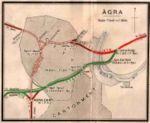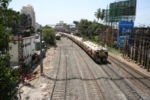How to interpret this infobox
| How to interpret this infobox | ||
|---|---|---|
 Agra rail connections, 1938 | ||
| Line of route | ||
| Agra East Bank to Belanganj Drummond Road to Alumganj | ||
| Gauge / mileage | ||
| Metre gauge | 11 miles (1892) 14 miles (1938) | |
| Timeline | ||
| 1890 | Work begun on existing broad gauge lines to create mixed gauge route | |
| 1892 | Line opened to traffic | |
| Key locations | ||
| Presidency | Bengal | |
| Stations | Agra East Bank, Agra Fort, Agra Idgah, , Raja-Ki-Mandi (GIPR), Drummond Road, Belanganj (BB&CIR) | |
| System agency | ||
| 1900 | worked by BB&CIR | |
| How to interpret this infobox | ||
A Line infobox is framed in grey and summarises information about a particular railway, or 'line'. In India, as in Britain, it was generally necessary to promote new lines as new companies in order to attract new capital. This allowed for the separation of risk and subscriptions from investors to be ring-fenced. It was also the way preferred by established companies or the Government of India (GOI) to float both new routes and extensions to existing railways if they provided the requisite finance.
It was not uncommon for the name of a proposed railway to be changed between initial survey and eventual opening to traffic.
Space is provided for an appropriate image or route diagram, together with caption. Click on the image to make it appear larger and use the back button of your browser to return to the page you were viewing.
- Line of route
- The principal route of the railway will be given in terms of its start and end points plus any subsidiary branchlines. If the starting point is a junction with another railway, then this will be shown first where there is no conflict with the line's name.
- Gauge/mileage
- The gauge(s) used together with the mileage open to traffic at given dates. For more on gauge, click here.
- 2' 6" NG = 2' 6" narrow gauge
- 2' 0" NG = 2' 0" narrow gauge
- Timeline
- Key dates in the development of the railway e.g. opening, nationalisation, closure. Use these to frame research strategies e.g. if an opening date is given as 1890, look in L/PWD/2 (railway correspondence), the Gazette of India or Thacker's editions for up to 5 years previously for possible entries detailing the initial survey and construction of the line.
- Key locations
- The Presidency (Bengal, Bombay or Madras) or Presidencies that the line operated in together with the main stations. Place names follow standard IRCA (Indian Railway Conference Association) or Imperial Gazetteer use, and link through to information about the location where possible. Locational information will help when searching directories like Thacker's.
- System agency
- Many lines were worked by a larger railway company as part of a wider system, or even by the GOI as a nationalised undertaking. Remember to check this company's records as well if tracking an ancestor.
A word or phrase of the data highlighted in blue indicates an internal link to another article which will provide further information. Use your browser's back button to return to this explanation. A word or phrase in red will indicate that although the link has been established, there is as yet no content to go to.
| How to interpret this infobox | ||
|---|---|---|
 Mumbai local trains | ||
| System timeline | ||
| 1908 | Company re-formed | |
| 1925 | Nationalised by GOI | |
| 1950 | Merged to form new IR Zone | |
| Constituent companies / lines | ||
| 1908 | Great Gondor Railway | |
| 1908 | Cirith Ungol Light Railway | |
| 1910 | Mount Doom Rack Railway | |
| Key locations | ||
| Headquarters | Minas Tirith | |
| Workshops | Mines of Moria | |
| Major Stations | Bywater, Edoras, Helm's Deep, Isengard, Mordor, Rivendell | |
| Successor system / organisation | ||
| 1950 | Middle-earth Railway (IR Zone) | |
| System mileage | ||
| BG | 1200 miles (1944) | |
| MG | 450 miles (1944) | |
| Associated auxiliary force | ||
| Rohan Railway Rifles | ||
| How to interpret this infobox | ||
A System infobox is framed in yellow and is used to provide information about the large groupings that developed over time. Sometimes,as with the East Indian Railway, both types of infobox are used. The name of the system will appear on the top title bar of the System infobox.
Space is provided for an appropriate image or route diagram, together with caption. Click on the image to make it appear larger and use the back button of your browser to return to the page you were viewing.
- System timeline
- Key dates in the history of the System - formation, takeover or merger of other lines, nationialisation. Effectively, railwaymen became civil servants when their line was nationalised. Knowing when this happened makes checking publications like the India List more straightforward.
- Constituent companies / lines
- Names of constituent undertakings with dates of merger or takeover
- Key locations
- Location of System Hedquarters, workshops, principal stations.
- Successor system / organisation
- Ultimately the zone of Indian Railways that the system became part of.
- System mileage
- Total mileage at date given for gauge stated.
- Associated auxiliary force
- Volunteer forces were part-time units which recruited from railway personnel. The major systems had their own battalions and regiments, and these have been identified among the Auxiliary Regiments.